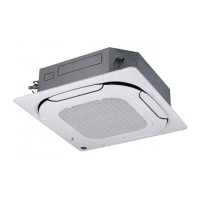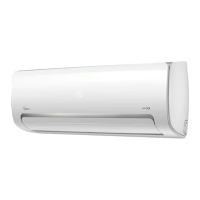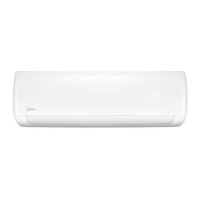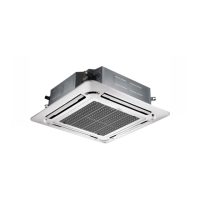4. Refrigerant Piping Installation
4.1 Length and Drop Height Requirements for the Piping
Connections to the Indoor and Outdoor Units
The length and drop height requirements for the refrigerant piping are different
for different indoor and outdoor units. Refer to the installation manual of the
outdoor unit.
4.2 Piping Material and Size
1. Piping material: Copper pipes for air handling.
2. Piping size: Choose and purchase copper pipes that correspond to the
length and size calculated for the selected model in the installation manual
of the outdoor unit and your actual project requirements.
4.3 Piping Layout
1. Seal the two ends of the piping properly before you connect the indoor and
outdoor piping. Once unsealed, connect the piping of the indoor and
outdoor units as quickly as possible to prevent dust or other debris from
entering the piping system via the unsealed ends, as this may cause the
system to malfunction.
2. If the piping needs to go through walls, drill the opening in the wall, and
place accessories like casings and covers for the opening properly.
3. Place the refrigerant connecting piping and the communication wiring for the
indoor and outdoor units together, and bundle them tightly to make sure air
does not enter and condensate to form water that may leak from the system.
4. Insert the bundled piping and wiring from outside the room through the wall
opening
into the room. Be careful when you lay out the piping. Do not
damage the piping.
4.4 Piping Installation
Refer to the installation manual attached with the outdoor unit on installation
of the refrigerant piping for the outdoor unit.
All gas and liquid piping must be properly insulated; otherwise, this may cause
water to leak. Use heat insulation materials that can withstand high tempera-
tures above 120°C to insulate the gas pipes. In addition, the insulation of the
refrigerant piping should be reinforced (20 mm or thicker) in situations where
there is high temperature and/or high humidity (when part of refrigerant piping
part is higher than 30°C or when the humidity exceeds RH80%). Otherwise,
the surface of the heat insulation material may be exposed.
Before the works are carried out, verify that the refrigerant is R410A. If the
wrong refrigerant is used, the unit may malfunction.
Other than the specified refrigerant, do not let air or other
gases enter the
refrigeration circuit.
If the refrigerant leaks during installation, make sure you fully ventilate the room.
Use two wrenches when you install or dismantle the piping, a common
wrench and a torque wrench. See Figure 4.1.
• Apply the appropriate tightening torque according to the installation
conditions. Excessive torque will damage the socket cap, and the cap will
not be tight if you apply insufficient torque, leading to leakages.
4.5 Air Tightness Test
Carry out the air tightness test on the system according to the instructions in the
installation manual of the outdoor unit.
4.7 Vacuum
Create a vacuum in the system according to the instructions in the installation
manual of the outdoor unit.
4.8 Refrigerant
Charge the system with refrigerant according to the instructions in the
installation manual of the outdoor unit.
4.6 Heat Insulation Treatment for Gas-Liquid Piping Connections
for the Indoor Unit
The heat insulation treatment is carried out on the piping at the gas and liquid
sides of the indoor unit respectively.
a. The piping on the gas side must use heat insulation material that can
withstand temperatures of 120°C and more.
b. For the piping connections of the indoor unit, use the insulation casing
for copper pipes (accessory 6) to carry out the insulation treatment,
and close all gaps.
Unit
body
Attached insulation
heat pump belt
On-site
piping side
Face upwards
Figure 4.5
Figure 4.1
Torque wrench
Pipe socket cap
Pipe fittings
Normal wrench
Slot the refrigerant piping into the brass nut (accessory 13), and expand the
pipe socket. Refer to the following table for the size of the pipe socket and
the appropriate tightening torque.
Figure 4.2
External diameter
(mm)
Tightening
torque
Figure 4.3
Apply refrigerant oil
Before the socket cap is installed on the pipe socket, apply some refrigerant
oil on the socket (both inside and outside), and then rotate it three or four
times before you tighten the cap. See Figure 4.3.
Precautions to take when welding the refrigerant pipes
• Before you weld the refrigerant pipes, fill the pipes with nitrogen first to
discharge the air in the pipes. If no nitrogen is filled during welding, a large
amount of oxide film will form inside the piping which may cause the air
conditioning system to malfunction.
• Welding can be carried out on the refrigerant pipes when the nitrogen gas
has been replaced or refilled.
• When the pipe is filled with nitrogen during welding, the nitrogen must be
reduced to 0.02 MPa using the pressure release valve. See Figure 4.4.
Figure 4.4
• The Air Tightness Test helps to ensure that the air and liquid cut-off
valves of the outdoor unit are all closed (maintain the factory defaults).
• For the vacuum, make sure that the air and liquid cut-off valves of the
outdoor unit are all closed (maintain the factory status).
Caution
Caution
R0.4~0.8
A
45°± 2
90°± 4
Flared opening
diameter (A)
Flared opening
Φ6.35 14.2-17.2N·m 8.3-8.7mm
Φ9.53 32.7-39.9N·m 12-12.4mm
Φ12.7 49.5-60.3N·m 15.4-15.8mm
Φ15.9 61.8-75.4N·m 18.6-19mm
Φ19.1 97.2-118.6N·m 22.9-23.3mm
Caution
Fi
ure 4.4
1 Copper piping
2 Section being brazed
3 Nitrogen connection
4 Hand valve
5 Pressure-reducing valve
6 Nitrogen
9

